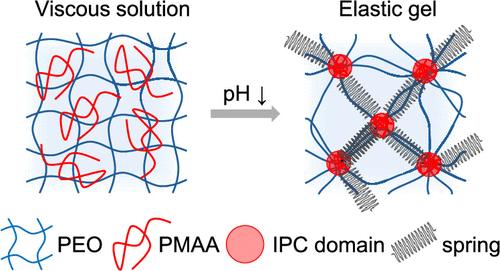聚环氧乙烷-聚甲基丙烯酸互聚配合物的ph响应流变性和结构
IF 5.2
1区 化学
Q1 POLYMER SCIENCE
引用次数: 0
摘要
本文研究了在不同pH值和聚合物比例下,聚环氧乙烷(PEO)与聚甲基丙烯酸(PMAA)之间形成的聚合物间配合物(IPCs)的流变学和结构特性。电位滴定法表明PMAA必须保持90%以上的质子化才能形成IPC。大量的流变学实验表明,在pH值5.75和4.75之间,从粘性到弹性的急剧转变。PEO链缠结和PEO - pmaa氢键交联是其流变反应的主要原因,交联在低pH下占主导地位,随着pH的增加而减弱。小角中子散射(SANS)强调了结构变化,在低pH下形成密集的、富含pmaa的结构域,在高pH下分解。这项工作为水凝胶的设计提供了有价值的新见解,其性质很容易通过聚合物混合比和pH来调节,为各种药物应用提供了潜力。本文章由计算机程序翻译,如有差异,请以英文原文为准。

pH-Responsive Rheology and Structure of Poly(ethylene oxide)–Poly(methacrylic acid) Interpolymer Complexes
This study investigates the rheological and structural properties of interpolymer complexes (IPCs) formed between poly(ethylene oxide) (PEO) and poly(methacrylic acid) (PMAA) at various pH levels and polymer ratios. Potentiometric titration showed that PMAA must remain over 90% protonated for IPC formation. Extensive rheological experiments revealed a sharp transition from viscous to elastic behavior between pH 5.75 and 4.75. The rheological response is attributed to PEO chain entanglements and PEO–PMAA hydrogen-bond cross-links, with cross-links dominating at low pH and weakening as pH increases. Small-angle neutron scattering (SANS) highlights the structural changes, with dense, PMAA-rich domains forming at low pH and breaking down at higher pH. This work provides valuable new insights for the design of hydrogels, whose properties are easily tuned by the polymer mixing ratio and pH, offering potential for various pharmaceutical applications.
求助全文
通过发布文献求助,成功后即可免费获取论文全文。
去求助
来源期刊

Macromolecules
工程技术-高分子科学
CiteScore
9.30
自引率
16.40%
发文量
942
审稿时长
2 months
期刊介绍:
Macromolecules publishes original, fundamental, and impactful research on all aspects of polymer science. Topics of interest include synthesis (e.g., controlled polymerizations, polymerization catalysis, post polymerization modification, new monomer structures and polymer architectures, and polymerization mechanisms/kinetics analysis); phase behavior, thermodynamics, dynamic, and ordering/disordering phenomena (e.g., self-assembly, gelation, crystallization, solution/melt/solid-state characteristics); structure and properties (e.g., mechanical and rheological properties, surface/interfacial characteristics, electronic and transport properties); new state of the art characterization (e.g., spectroscopy, scattering, microscopy, rheology), simulation (e.g., Monte Carlo, molecular dynamics, multi-scale/coarse-grained modeling), and theoretical methods. Renewable/sustainable polymers, polymer networks, responsive polymers, electro-, magneto- and opto-active macromolecules, inorganic polymers, charge-transporting polymers (ion-containing, semiconducting, and conducting), nanostructured polymers, and polymer composites are also of interest. Typical papers published in Macromolecules showcase important and innovative concepts, experimental methods/observations, and theoretical/computational approaches that demonstrate a fundamental advance in the understanding of polymers.
 求助内容:
求助内容: 应助结果提醒方式:
应助结果提醒方式:


